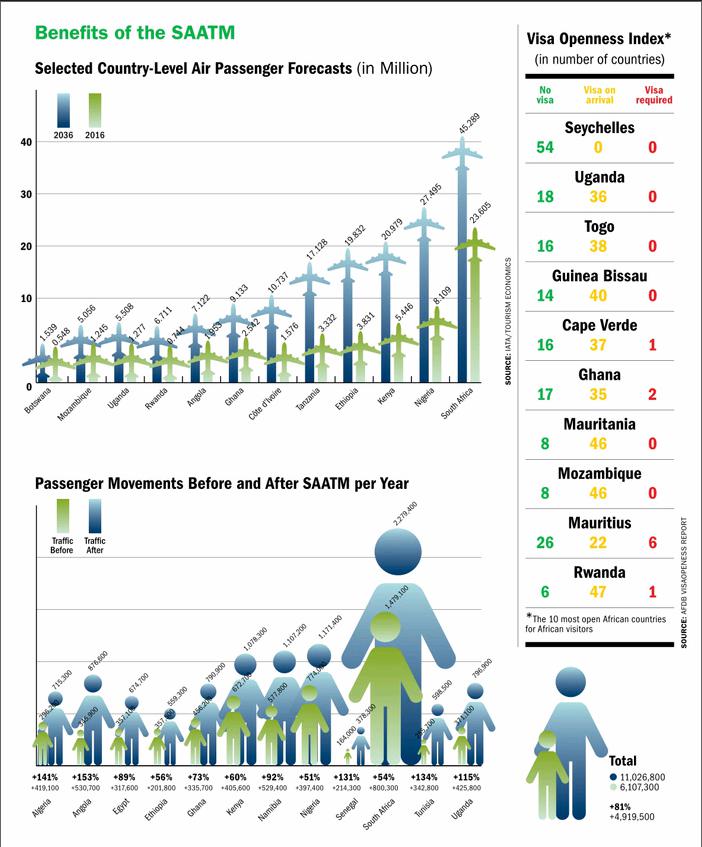Open Skies for Africa
By+Aggrey+Mutambo

in Africa, flying from one part to another can often take longer than traveling to Europe or the Americas. Long layovers and delays occasioned by electric power failures, expensive tickets and tough protectionist regulations combine to make air travel a nightmare.
In fact, people on the continent used to travel between regions by first transiting through Europe, which would add seven or more hours on their journey.
Now the African Union (AU) seems to be responding. In January, gathered at Addis Ababas AU Headquarters, leaders and experts on aviation launched a declaration that would remove or ease these troubles in air transport.
Known as the Single African Air Transport Market (SAATM), the AU hopes to use this program to “unify” air transport in Africa through “liberalization of civil aviation,” part of the long term integration program.
Integrated continent opportunities
The Treaty for SAATM, already signed by 23 of AUs 55 members, including big economies like South Africa, Kenya, Nigeria and Egypt, is part of the AUs Agenda 2063, seeking to have a prosperous and more integrated continent in the coming half a century. So how will it work? Abou-Zeid Amani, Commissioner for Infrastructure and Energy of AU Commission, told reporters that the program, once ratified, will see the members adopt their regulations on fair competition, consumer protection and safety standards besides reducing tariffs that limit access to their markets.
“It will help the signatory countries stimulate their economies, further promote trade among themselves, and give a tremendous boost to tourism,” she said. “Making it easier to travel by air is a positive step to having an integrated continent and we hope that all the members will sign this document.”
Aviation experts generally agree that Africas industry cannot run on the old system. According to the International Air Transport Association (IATA), the continents passenger number could double in the next two decades, rising to 274 million by 2036. This could be fertile ground for new entrants and existing operators to expand and take advantage of this growth.
But there is a problem: IATA says African airlines could make a combined loss of $100 million in 2018. This is because airlines are heavily taxed, mostly to finance subsidies for domestic fuel. Most airlines are heavily indebted and are generally operating with monopolies for services like catering, repairs and fueling. In addition, the dearth of sufficient airports across Africa means airlines cannot maximize their potential by having more connections.
“The status quo is not working for African aviation,” said Raphael Kuuchi, IATAs Vice President for Africa.
“Aviation in Africa is a key economic enabler and there is potential for it. But we are going to need proper policies to support the industry,” he told delegates at SAATM, a sideline of the 30th AU Summit held from January 22 to 29 in Addis Ababa.
Saving time and money
The continent has almost 250 airlines, some operating regional networks while most fly local trips. But only two airlines, Kenya Airways and Ethiopian Airlines, have connections to more than half of the other destinations on the continent.
IATA recently did a study called Benefits of the SAATM on the impact of an open sky policy on the economies of 12 countries such as South Africa, Kenya, Nigeria, Ethiopia and Egypt. The findings were startling. “At least$1.3 billion of incremental GDP would be pumped in these economies and 155,000 additional jobs created,” said Kuuchi.
What is more, the study done on the 12 economies, which also includes Namibia,Angola, Uganda, Rwanda, Tunisia, Algeria and Burundi, showed passengers will get 75 percent increase in direct services and they could save up to one third of the money spent today on air ticket prices, or$500 million a year.
“We will save time. It will be convenient to fly and 5 million more passengers will come to fly with us,” says the study.
Observers think open skies should be supported with more facilities and the construction boom seen across Africa and fueled by donors like China, the World Bank and the African Development Bank (AfDB) are welcome.
“Africas aviation industry will grow very fast as there is much room for expansion,” Ritz Akkum, Operations Manager at the Cameroonian Civil Aviation Authority told ChinAfrica recently. “But we need more in investments in airport infrastructures, which I think will increase given more African countries are becoming aware of the central role of aviation to economic growth.”
Differing opinions
Despite the opportunities of SAATM, not all are convinced of its positive impact. Nigerias This Day newspaper reported on January 24 that Nogie Meggison, President of Airline Operators of Nigeria, said that before taking decisions on SAATM, Nigerias technical team should have been brought on board so that they could consider how the policies would benefit Nigeria.
“We must put Nigeria first,” said Meggison.“If we open the skies, what advantages does Nigeria stand to gain? The domestic airlines are not comfortable with the policy. Do we have visas to travel around Africa before we open the skies? Are the taxes in Nigeria and that of other countries uniform?”asked Meggison. However, Managing Director of the Nigerian Airspace Management Agency Fola Akinkuotu was also quoted in This Day, saying Nigeria is committed to the full implementation of SAATM.
Akinkuotu said Africa should take advantage of the great potential offered by SAATM to enhance traffic connectivity and projected growth in passenger volumes over the next few years.
“We must all, therefore, strive to commit to the full implementation and operationalization of SAATM; we need to leap forward so as to become an effective global competitor in aviation,” he said. “In this regard, Nigeria is one of the 23 states that have so far made Solemn Commitment to the implementation of SAATM by 2018.”
Regional airports key
To demonstrate how improved aviation facilities and policies create jobs, the AfDB recently co-financed a $652-million Blaise Diagne International Airport in Senegal, another of the projects meant to improve air transportation in Africa. When the project was completed in December last year, AfDB officials announced that a total of 3,000 local jobs had been created during the construction phase, 427 full-time jobs created after operations started with more jobs expected in engineering, maintenance, security and information technologies.
“This airport will improve regional connectivity, drive down costs of transportation, and grow and transform the economy,”AfDB President Akinwumi Adesina said in a statement.
“The state-of-the-art airport facility will be a catalyst for the emergence of small and medium enterprises, attract regional and foreign investments and boost Senegals tourism potential,” he added.
The new airport provides 42,000 square meters of space for terminals and a further 12,800 square meters for cargo, which the AfDB sees as “a long-term solution to intra-African economic activity; and resolves a perennial problem of low levels of aviation connectivity in West and Central Africa.”
The regions are considered “most disadvantaged” by the AfDB despite a huge suppressed demand because there is no established inter-regional airline there to ferry people to other parts of the continent.
But Senegal is not the only country busy with airport construction. Rwanda, Kenya and Ethiopia are others investing heavily in airports. In November 2017, the Kenyan Government announced plans to build a second runway at the main airport in Nairobi. Due to the cost of $160 million, the project is expected to see an increase in the number of passengers with the added facility of Nairobi saying all Africans will receive visas on arrival.

